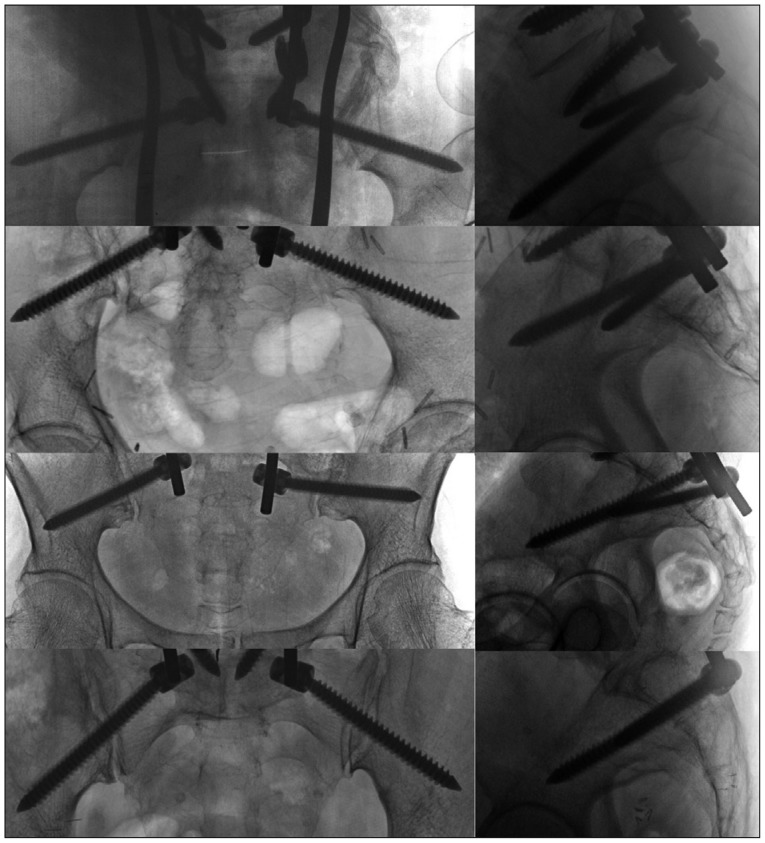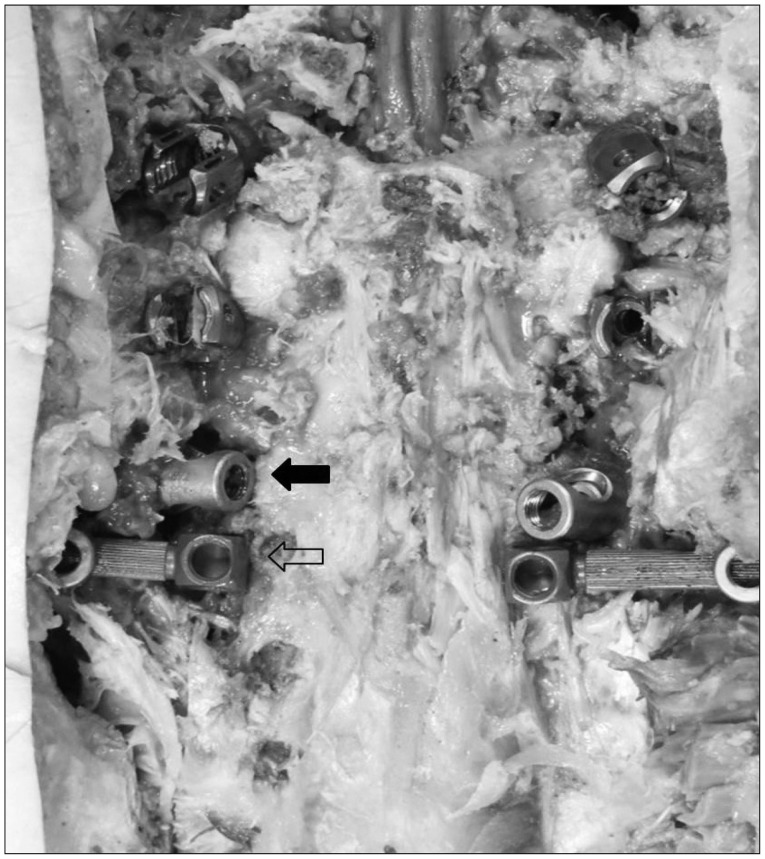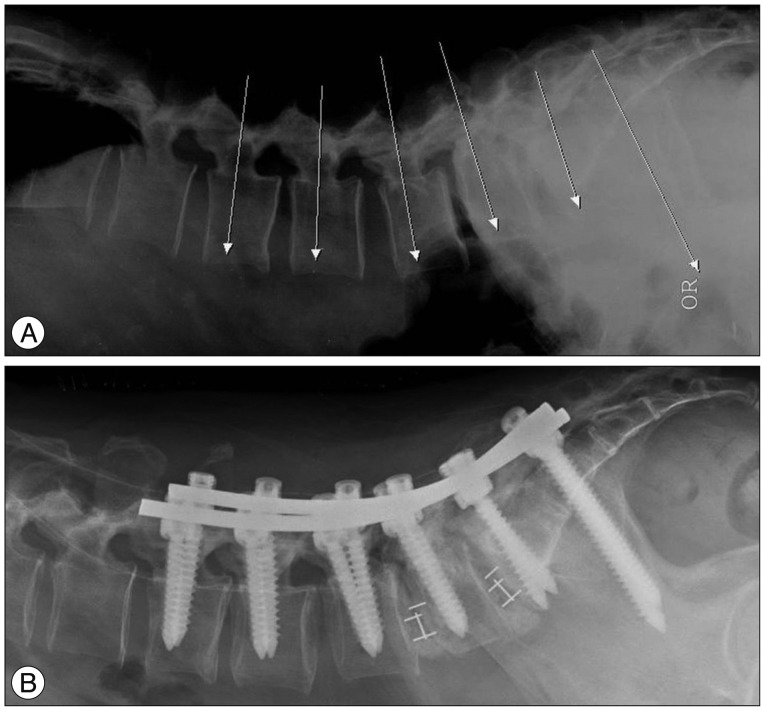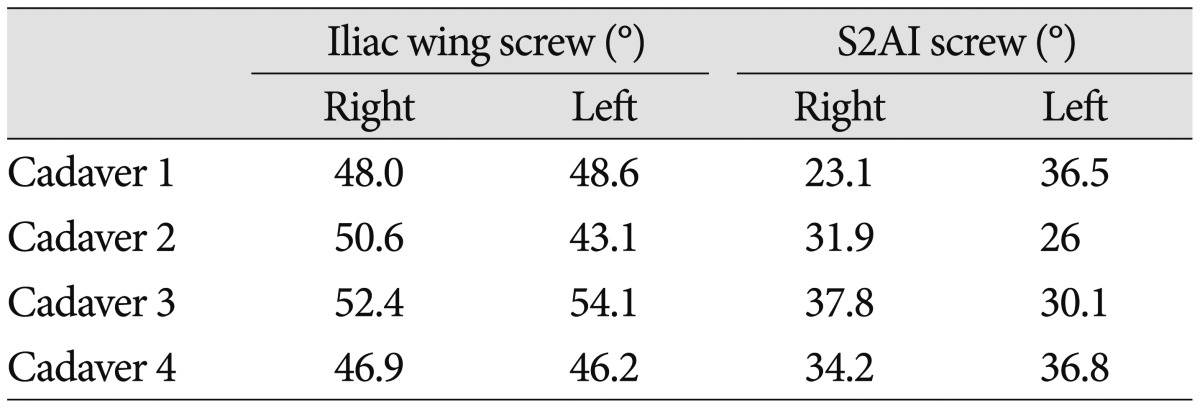Abstract
A rigid spino-pelvic fixation to anchor long constructs is crucial to maintain the stability of long fusion in spinal deformity surgery. Besides obtaining immediate stability and proper biomechanical strength of constructs, the S2 alar-iliac (S2AI) screws have some more advantages. Four Korean fresh-frozen human cadavers were procured. Free hand S2AI screw placement is performed using anatomic landmarks. The starting point of the S2AI screw is located at the midpoint between the S1 and S2 foramen and 2 mm medial to the lateral sacral crest. Gearshift was advanced from the desired starting point toward the sacro-iliac joint directing approximately 20° angulation caudally in sagittal plane and 30° angulation horizontally in the coronal plane connecting the posterior superior iliac spine (PSIS). We made a S2AI screw trajectory through the cancellous channel using the gearshift. We measured caudal angle in the sagittal plane and horizontal angle in the coronal plane. A total of eight S2AI screws were inserted in four cadavers. All screws inserted into the iliac crest were evaluated by C-arm and naked eye examination by two spine surgeons. Among 8 S2AI screws, all screws were accurately placed (100%). The average caudal angle in the sagittal plane was 17.3±5.4°. The average horizontal angle in the coronal plane connecting the PSIS was 32.0±1.8°. The placement of S2AI screws using the free hand technique without any radiographic guidance appears to an acceptable method of insertion without more radiation or time consuming.
A rigid spino-pelvic fixation to anchor long constructs is crucial to maintain the stability of long fusion in spinal deformity surgery. Many authors reported that S1 promontory (tricortical purchase) screws without supplemental fixation are associated with fixation failure which causes high pseudarthrosis rate and poor outcome234). Sacropelvic fixation is most commonly used during long segmental fusions extending to the sacrum for spinal deformity, correction of pelvic obliquity, high-grade lumbosacral spondylolisthesis (grade III or higher), sacrectomy, osteoporotic fractures or traumatic fractures, substantial osteoporosis in the setting of lumbosacral fusion36). In addition, revision of symptomatic lumbosacral pseudarthrosis with loosened S1 screws is another indication for extension of fixation to the pelvis. Iliac fixation with iliac screws is one of the most commonly used techniques for sacropelvic fixation. However, it requires separate fascial skin incisions or wide muscle dissection to expose the ilium or the use of offset connectors which might cause skin prominence over the posterior superior iliac spine. This increases operation time, possibility of deep wound infection, and risk of poor wound healing.
S2 alar-iliac (S2AI) screws have been described by O'Brien et al.7) in pediatric and adult populations, respectively. Besides obtaining immediate stability and proper biomechanical strength of constructs, the S2AI screws have some more advantages1). It could eliminate the need for cross-connectors which minimizes implant prominence because it might be placed in-line with S1 promontory screws. Additionally, it does not require the dissection of the subcutaneous tissue over the iliac crest or the sacral paraspinal muscle. The implant can be completely covered by an intact layer of muscle and minimally disturbed skin.
We report a free-hand insertion technique of S2AI screws which can reduce radiation exposure to the surgeons and surgical time, and the anatomic feasibility of the S2AI screw placement in-line with conventional iliac wing screw in four cadavers.
Four Korean fresh-frozen human cadavers were procured and surgically dissected from proximal thoracic to pelvis, leaving bony structures and ligaments intact. Each specimen was inspected and examined under fluoroscopy to rule out deformities, prior surgery, or malignancy. 8.5×90 mm iliac screws (CD horizon® Legacy™ Spinal System, Medtronic, Memphis, TN, USA) were placed for the S2AI screw.
Free hand S2AI screw placement was performed using anatomic landmarks. The starting point of the S2AI screw is located at the midpoint between the S1 and S2 foramen and 2 mm medial to the lateral sacral crest (Fig. 1A). Additionally, the entry point for S2AI should be harmoniously located with S1 screw entry point. A 3 mm cutting burr was utilized to create posterior cortical breach, approximately 5 mm in depth. The gearshift was initially pointed dorsally to avoid penetration of the anterior sacrum (Fig. 1B). Gearshift was advanced from the desired starting point toward the sacro-iliac (SI) joint directing approximately 20° angulation caudally in sagittal plane and 30° angulation horizontally in the coronal plane connecting the posterior superior iliac spine (PSIS). After inserting the gearshift tip approximately 3–4 cm until reaching the SI joint, the gearshift was removed and confirmed 5 bony walls (medial, lateral, superior, inferior and bottom) through ball-tip probing. This step identifies the intraosseous placement of the screw trajectory. It could be hard to advance the gearshift because of the cortical wall of the SI joint. By cautious hammering the gearshift with the mallet, it could penetrate the cortical wall of the SI joint. After crossing the SI joint, the tip of the gearshift turned to face ventral (Fig. 1B). The gearshift was preceded through the cancellous channel of the ilium heading above the superior rim of the sciatic notch. It is important to make sure that surgeon to feel the bone of entire length of the tract. A ball-tip probe was utilized to palpate the 5 bony borders ensuring that the screw would be located intraosseously. At this point, if a soft tissue breach is palpated, there may be an opportunity to redirect the gearshift probe into an appropriate position into the iliac crest. If any wall including the anterior has been breached, the iliac wing crest may be salvageable. Otherwise, we place bone wax or gelfoam in the sacral hole to eliminate the bleeding and re-angle the pedicle finder with a more appropriate trajectory. The S2AI screw tract was under-tapped with a 2 mm less diameter tap than the intended screw. Following this, the tract is palpated again to make sure that the osseous borders are intact. This second palpation will often allow palpation of distinct bony ridges confirming intraosseous position and the tract length was remeasured by the length of the ball-tip probe marked with a hemostatic clamp. This measurement was compared directly adjacent to the screw to be placed to ensure appropriate screw length. Finally, the screw was inserted in the same direction until the screw head is placed in-line with S1 promontory screw head.
It is imperative that the surgeon document intraosseous placement via fluoroscopy or plain radiography. On the lateral and coronal plane radiograph, the S2AI screws should be placed above the superior rim of the sciatic notch (Fig. 1C). The most important structure to be avoided is the sciatic notch. However, rather than using a trajectory that passes far from the notch, the ideal trajectory of the S2AI screw is situated immediately above the notch so that the bottom threads of the screw will be in contact with the cortical bone forming the upper limit of the notch, providing a better pull-out strength5).
Our criteria for accurate placement were as follows; first, after under-tapping, two surgeons confirmed the screw trajectory was located intraosseously by palpating intact 5 bony walls using ball-tip probe. Second, we checked AP and lateral C-arm fluoroscopy; the screws should not violate sciatic notch, acetabulum; the screws should not evade the pelvic cavity; the screws should locate in the ilium.
A total of eight S2AI screws were inserted in four cadavers. All screws inserted into the iliac crest were all evaluated by C-arm and naked eye examination. Among 8 S2AI screws, all screws were accurately placed (Fig. 2). The average caudal angle in the sagittal plane was 17.3±5.4°. The average horizontal angle in the coronal plane connecting the PSIS was 32.0±1.8°. The average caudal angles and horizontal angles of the conventional wing screw were 32.9±6.7°and 48.7±3.5°, respectively (Table 1, 2).
Solid distal fixation in spinal deformity surgery is essential for providing a strong support to maintain sagittal and coronal balance. S2AI screw fixation technique has more fixed segments and stable biomechanical torsion due to the direction and the length of the screws, leading to more reliable stability compared to traditional iliac screw fixation8). S2AI screw fixation technique provides as far anteriorly and laterally to the spine as possible. In addition, S2AI screws traverse the cortical bone of the sacrum, the SI-joint space, and the cortical bone of the ilium, which significantly enhances the pullout strength of the screws.
It has been reported that 60% of S2AI screws violated the articular cartilage of the SI joint, because the superior portion of the lateral projection of the sacrum to the ilium corresponds to an articular area7). However, fusion of the SI joint after placement of S2AI screws has proved to provide significant pain relief in patients with pain related to SI joint degeneration5).
In this study, all S2AI screws were in-line with the S1 promontory screws. Furthermore, all S2AI screws were in-line with the conventional iliac wing screws with the offset connector (Fig. 3). We consider it is feasible for the S2AI screw to place in-line with the S1 promontory screws and the conventional iliac wing screws.
Screw placement under fluoroscopic guidance requires more surgical time and results in radiation exposure to surgeon during surgery. Surgeons should protect themselves from radiation exposure with wearing eyewear, thyroid shields, and lead aprons. However, protecting gears are heavy and wearing them causes fatigue to surgeons, which decreases surgeons' concentration. Even though a surgeon wore all the protecting gears mentioned above, the surgeon's hands could not be saved from the radiation exposure. The placement of pedicle screws or S2AI screws using a free hand technique is useful for surgeon minimalizing the radiation exposure from the fluoroscopy and reducing operation time.
It deserves to mention our surgical tip for measuring the screw angle during the surgery. We take a portable lateral plain radiograph for leveling after flipping a patient. We draw imaginary lines for the ideal pedicle screw trajectory and S2AI screw trajectory on the lateral plain radiograph, which is placed just above the superior rim of the sciatic notch. These lines become a reference lines (Fig. 4). Based on the reference line, for free hand screw insertion, we can estimate or modify the pedicle screw angle and the caudal angle for the S2AI screw.
Acknowledgements
We appreciate the assistance of Mijin Jung, the artist who drew Figure 1, 2, and 3 in this manuscript. She worked as a medical illustrator for the Department of Neurosurgery, Baylor College of Medicine from 2009 to 2011, and has worked in the Department of Neurosurgery, Seoul National University Bundang Hospital, Seoul National University College of Medicine since 2013.
References
1. Chang TL, Sponseller PD, Kebaish KM, Fishman EK. Low profile pelvic fixation : anatomic parameters for sacral alar-iliac fixation versus traditional iliac fixation. Spine (Phila Pa 1976). 2009; 34:436–440. PMID: 19247163.
2. Edwards CC 2nd, Bridwell KH, Patel A, Rinella AS, Berra A, Lenke LG. Long adult deformity fusions to L5 and the sacrum. A matched cohort analysis. Spine (Phila Pa 1976). 2004; 29:1996–2005. PMID: 15371700.

3. Hyun SJ, Rhim SC, Kim YJ, Kim YB. A mid-term follow-up result of spinopelvic fixation using iliac screws for lumbosacral fusion. J Korean Neurosurg Soc. 2010; 48:347–353. PMID: 21113363.

4. Kim YJ, Bridwell KH, Lenke LG, Cho KJ, Edwards CC 2nd, Rinella AS. Pseudarthrosis in adult spinal deformity following multisegmental instrumentation and arthrodesis. J Bone Joint Surg Am. 2006; 88:721–728. PMID: 16595461.

5. Mattei TA, Fassett DR. Combined S-1 and S-2 sacral alar-iliac screws as a salvage technique for pelvic fixation after pseudarthrosis and lumbosacropelvic instability : combined S-1 and S-2 sacral alar-iliac screws as a salvage technique for pelvic fixation after pseudarthrosis and lumbosacropelvic instability : technical note. J Neurosurg Spine. 2013; 19:321–330. PMID: 23808582.

6. O'Brien JR, Yu W, Kaufman BE, Bucklen B, Salloum K, Khalil S, et al. Biomechanical evaluation of S2 alar-iliac screws : effect of length and quad-cortical purchase as compared with iliac fixation. Spine (Phila Pa 1976). 2013; 38:E1250–E1255. PMID: 23759811.
7. O'Brien JR, Yu WD, Bhatnagar R, Sponseller P, Kebaish KM. An anatomic study of the S2 iliac technique for lumbopelvic screw placement. Spine (Phila Pa 1976). 2009; 34:E439–E442. PMID: 19454996.
8. Zhu F, Bao HD, Yuan S, Wang B, Qiao J, Zhu ZZ, et al. Posterior second sacral alar iliac screw insertion : anatomic study in a Chinese population. Eur Spine J. 2013; 22:1683–1689. PMID: 23508334.

Fig. 1
A : The entry point of the S2 alar-ilac (S2AI) screw is located at the midpoint between the S1 and S2 foramen and 2 mm medial to the lateral sacral crest. Caudal angle in the sagittal plane is marked (*). B : Left, horizontal angle in the coronal plane connecting the posterior superior iliac spine is marked (*). Right, the gearshift is initially pointed dorsally as a safety measure to avoid anterior wall perforation of the iliac crest. After crossing the sacro-iliac joint, the tip of the gearshift turned to face ventrally. C : On the lateral plane radiograph, the S2AI screws should be placed above the superior rim of the sciatic notch.

Fig. 2
On the AP and lateral C-arm fluoroscopy after placing the S2 alar-iliac (S2AI), we confirmed that all screws did not violate the sciatic notch and acetabulum. All screws located in the ilium. AP : anterior-posterior.

Fig. 3
S2 alar-iliac (S2AI) screws were in-line with the conventional iliac wing screws with the offset connector. Black arrow indicates S2AI screw, whereas hollow arrow indicates conventional iliac wing screw with the offset connector.

Fig. 4
A : Imaginary lines for the ideal pedicle screw and S2 alar-iliac screw trajectory on the intra-operative lateral plain radiograph, which was taken after flipping a patient. These lines become a reference lines. B : Intraoperative portable plain radiograph after placing the screws shows that all screws were inserted correctly.





 PDF
PDF ePub
ePub Citation
Citation Print
Print




 XML Download
XML Download